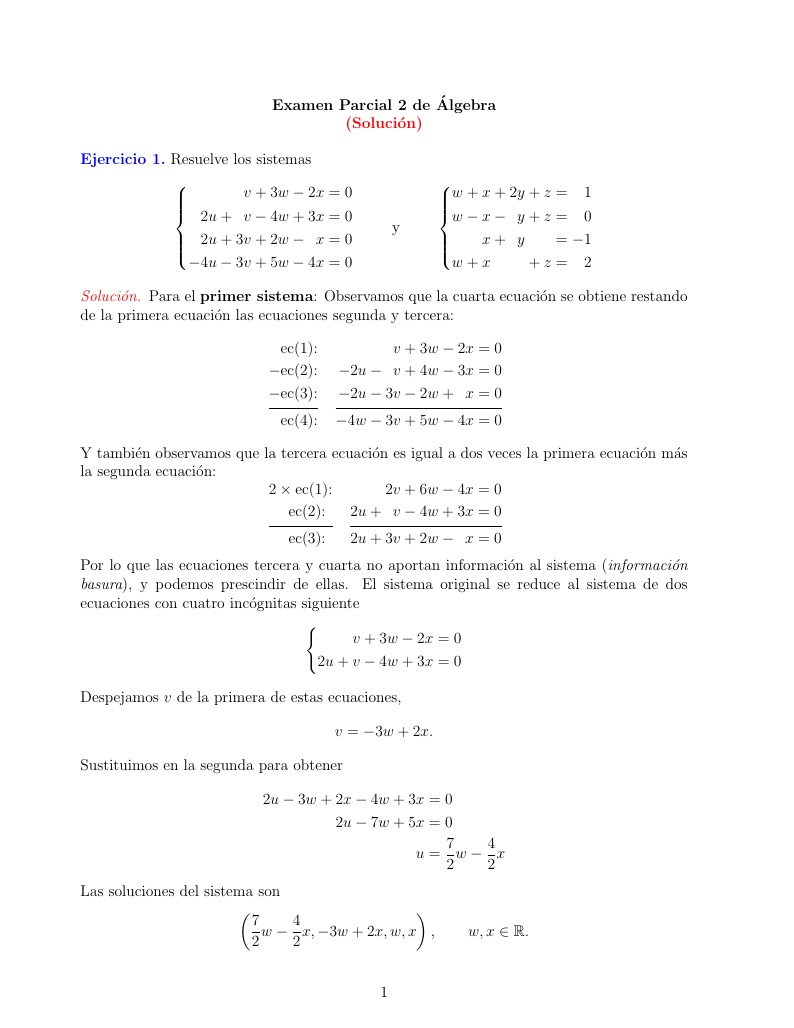
Solucion parcial 2
Author:
Memo Garro
Last Updated:
8 years ago
License:
Creative Commons CC BY 4.0
Abstract:
Solución al segundo examen parcial de álgebra

\begin
Discover why over 20 million people worldwide trust Overleaf with their work.
Solución al segundo examen parcial de álgebra

\begin
Discover why over 20 million people worldwide trust Overleaf with their work.
\documentclass[12pt,oneside,geqno]{article}
\addtolength{\textheight}{120pt}
\oddsidemargin=-10pt
\topmargin=-.5in
\textwidth=6.5in
%\pagestyle{empty}
\usepackage{amssymb,latexsym,amsmath,amsthm}
\usepackage{amsfonts,rawfonts}
\usepackage{thmtools}
\usepackage{systeme}
\usepackage{mathtools}
\usepackage[usenames,dvipsnames]{color}
\usepackage{xcolor}
\declaretheoremstyle[
headfont=\color{blue}\normalfont\bfseries,
notefont=\bfseries,
notebraces={}{},
%bodyfont=\color{red}\normalfont\itshape,
bodyfont=\normalfont,%\itshape,
%headformat=\NUMBER.~\NAME\NOTE
headformat=\NAME\NOTE
]{colorejercicio}
\declaretheorem[
%numbered=no,
style=colorejercicio,
name=Ejercicio
]{ejercicio}
\begin{document}
\begin{center}
{\bf Examen Parcial 2 de \'Algebra}
{\bf \color{red}{(Soluci\'on)}}
\end{center}
\begin{ejercicio}[1]
Resuelve los sistemas
\[
\systeme{v+3w-2x=0,
2u+v-4w+3x=0,
2u+3v+2w-x=0,
-4u-3v+5w-4x=0}
\qquad\text{ y }\qquad
\systeme{w+x+2y+z=\phantom{-}1,
w-x-y+z=\phantom{-}0,
x+y=-1,
w+x+z=\phantom{-}2}
\]
\end{ejercicio}
\begin{proof}[\color{red}{Soluci\'on}]
Para el {\bf primer sistema}: Observamos que la cuarta ecuaci\'on se obtiene restando de la primera ecuaci\'on las ecuaciones segunda y tercera:
\[
\begin{alignedat}{2}
&\text{ec(1):}\\
-&\text{ec(2):}\\
-&\text{ec(3):}\\[0.25em]
\hline\\[-1.25em]
&\text{ec(4):}
\end{alignedat}
\quad
\begin{alignedat}{5}
& & v & {}+{} & 3w & {}-{} & 2x = 0 \\
-2u & {}-{} & v & {}+{} & 4w & {}-{} & 3x = 0 \\
-2u & {}-{} & 3v & {}-{} & 2w & {}+{} & x = 0 \\[0.25em]
\hline\\[-1.25em]
-4w & {}-{} & 3v & {}+{} & 5w & {}-{} & 4x =0
\end{alignedat}
\]
Y tambi\'en observamos que la tercera ecuaci\'on es igual a dos veces la primera ecuaci\'on m\'as la segunda ecuaci\'on:
\[
\begin{alignedat}{2}
&2\times\text{ec(1):}\\
&\phantom{2\times}\text{ec(2):}\\[0.25em]
\hline\\[-1.25em]
&\phantom{2\times}\text{ec(3):}
\end{alignedat}
\quad
\begin{alignedat}{5}
& & 2v & {}+{} & 6w & {}-{} & 4x = 0 \\
2u & {}+{} & v & {}-{} & 4w & {}+{} & 3x = 0 \\[0.25em]
\hline\\[-1.25em]
2u & {}+{} & 3v & {}+{} & 2w & {}-{} & x = 0
\end{alignedat}
\]
Por lo que las ecuaciones tercera y cuarta no aportan informaci\'on al sistema ({\em informaci\'on basura}), y podemos prescindir de ellas. El sistema original se reduce al sistema de dos ecuaciones con cuatro inc\'ognitas siguiente
\[
\systeme{v+3w-2x=0,
2u+v-4w+3x=0}
\]
Despejamos $v$ de la primera de estas ecuaciones,
\[
v=-3w+2x.
\]
Sustituimos en la segunda para obtener
\begin{align*}
2u-3w+2x-4w+3x&=0\\
2u-7w+5x&=0\\
u&=\frac72w-\frac42x
\end{align*}
Las soluciones del sistema son
\[
\left(\frac72w-\frac42x,-3w+2x,w,x\right),\qquad w,x\in\mathbb{R}.
\]
Para el {\bf segundo sistema}: Si sumamos las ecuaciones segunda y tercera, obtenemos
\[
w+z=-1.
\]
Y si sumamos las ecuaciones primera y cuarta obtenemos
\begin{align*}
2(w+z)+2(x+y)&=3\\
2(w+z)-2&=3\quad \text{\footnotesize(por la tercera ecuaci\'on: $x+y=-1$)}\\
w+z&=\frac52.
\end{align*}
Una inconsistencia. En consecuencia el sistema no tiene soluci\'on.
{\bf Observaci\'on:} Desde luego estas no son las \'unicas formas de resolver este ejercicio.
\end{proof}
\begin{ejercicio}[2]
Encuentra para qu\'e valores de $k\in\mathbb{Z}$, si existen, el sistema tiene ($a$) soluci\'on \'unica, ($b$) una infinidad de soluciones, ($c$) no tiene soluci\'on.
\[
\begin{alignedat}{4}
x & {}+{} & y & {}+{} & kz & =\phantom{-}1\\
x & {}+{} & ky & {}+{} & z & = \phantom{-}1\\
kx & {}+{} & y & {}+{} & z & = -2
\end{alignedat}
\]
\end{ejercicio}
\begin{proof}[\color{red}{Soluci\'on}]
La matriz de coeficientes del sistema es
\[
A:=
\begin{pmatrix}
1 & 1 & k\\
1 & k & 1\\
k & 1 & 1
\end{pmatrix}
\]
El sistema tiene soluci\'on \'unica si y s\'olo si $|A|\ne0$.
Ahora vamos a calcular $|A|$. Tenemos
\begin{align*}
|A|&=
\begin{vmatrix}
k & 1\\
1 & 1
\end{vmatrix}-
\begin{vmatrix}
1 & 1\\
k & 1
\end{vmatrix}+k
\begin{vmatrix}
1 & k\\
k & 1
\end{vmatrix}\\
&=(k-1)-(1-k)+k(1-k^2)\\
&=(k-1)(2-k(k+1))\\
&=(k-1)(2-k-k^2)
\end{align*}
Luego,
\begin{align*}
|A|=0&\ \Leftrightarrow (k-1)(2-k-k^2)=0\\
&\ \Leftrightarrow\ k-1=0\quad\text{\'o}\quad2-k-k^2=0\\
&\ \Leftrightarrow\ k=1\quad\text{\'o}\quad k^2+k+\frac14=2+\frac14\\
&\ \Leftrightarrow\ k=1\quad\text{\'o}\quad\left(k+\frac12\right)^2=\frac94\\
&\ \Leftrightarrow\ k=1\quad\text{\'o}\quad k+\frac12=\pm\frac32\\
&\ \Leftrightarrow\ k=1\quad\text{\'o}\quad k=\pm\frac32-\frac12\\
&\ \Leftrightarrow\ k=1\quad\text{\'o}\quad(k=1\ \text{y}\ k=-2)\\
&\ \Leftrightarrow\ k=1\quad\text{\'o}\quad k=-2.
\end{align*}
Por lo que el sistema tiene soluci\'on \'unica si $k\ne1,-2$. ({\bf Observaci\'on}: No es necesario encontrar expl\'icitamente las soluciones, ya que esto no es parte del problema).
Por otro lado, si $k=1$, entonces las ecuaciones primera y segunda entran en contradicci\'on con la tercera, por lo que el sistema es inconsistente (no tiene soluci\'on).
Resta analizar el caso $k=-2$. El sistema en este caso es
\[
\begin{alignedat}{4}
x & {}+{} & y & {}-{} & 2z & = \phantom{-}1 \\
x & {}-{} & 2y & {}+{} & z & = \phantom{-}1 \\
-2x & {}+{} & y & {}+{} & z & = -2
\end{alignedat}
\]
De las ecuaciones primera y segunda obtenemos las igualdades
\begin{align*}
x+y-2z&=x-2y+z\\
3y&=3z\\
y&=z.
\end{align*}
Sustituyendo $y=z$ en la primera ecuaci\'on, obtenemos
\begin{align*}
x+z-2z&=1\\
x-z&=1\\
x&=1+z.
\end{align*}
Por lo que si $k=-2$, el sistema tiene una infinidad de soluciones dadas por
\[
(1+z,z,z),\qquad z\in\mathbb{R}.
\]
\end{proof}
\end{document}